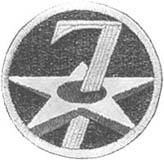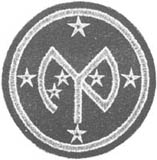 |
Seventh Air Force |
| V Amphibious Corps |  |
 |
27th Division |
THE COST OF CAPTURING MAKIN in casualties among Army personnel was not great; 58 killed in action, 8 died of wounds, 150 wounded in action, and 35 injured, but not in combat.1 At Tarawa, losses were much more severe among the more numerous assault forces: 913 killed and missing, and 2,037 wounded, among the Marines; 26 killed and 48 wounded, among the Navy. At Makin, moreover, the Navy losses greatly exceeded those of the Army. During the preparatory bombardment on D Day, a turret fire on the Mississippi killed 40 men and injured 9. In the boat crews and the beach parties, seven were wounded or injured, while three died of wounds. Combat and operational losses on 8 carriers, not including the ill-fated Liscombe Bay, totaled 7 killed and 18 injured. The submarine Plunger, on rescue patrol, while picking up a flier from the Lexington, was strafed by Japanese planes, and six of its crew were wounded. Finally, when the Liscombe Bay went down, 702 men were lost and her 257 survivors were taken aboard the transports in various stages of injury, principally from burns. Besides the loss of the carrier itself and 19 planes based on it, 9 other planes were lost in combat and 35 in operational mishaps. Consolidated naval casualties were, then, 752 killed or died of wounds, 291 wounded or injured, 63 planes lost, and one escort carrier sunk.
For this expenditure at Makin, and by the battle of Tarawa and the unopposed seizure of Apamama, the American forces obtained strategic advantages which had been anticipated. Shorter lines to the Southwest Pacific could now be maintained and Japanese interference with them could be more readily neutralized. A base was gained for operations against the Marshall Islands.
1. Army casualties were distributed as follows: infantry, 178; tank corps, 25; engineers, 21; medical corps, 9; field artillery, 6; coast artillery (AA), 3; signal corps, 3; air corps, 1; unidentified, 5.
132
In the fighting which lay ahead, the Army derived another advantage from its capture of Makin. From that experience in taking a Pacific atoll it learned valuable lessons. Participants in the Makin campaign, from higher levels of command to the smallest combat units, sifted their observations and submitted reports and recommendations.
In reviewing the operation, the participants recognized that the tactical plan had, on the whole, been vindicated by the results, Certain errors on which it had been based seemed when analyzed to offset each other. The fact that the beaches were all incapable of efficient use was balanced by the enemy's weakness, even greater than had been anticipated. He was not able to oppose the landings effectively nor to strike the beaches from the air during the period preceding their defense by antiaircraft artillery. The expectation that the enemy could be enveloped by first attacking from the west and then sending one BLT to strike his rear from Yellow Beach was not realized, for he did not move out to oppose the invasion from the west with the main body of his forces. Nevertheless, whatever plan of defense may have existed was disorganized by the prearranged fire, the air strikes, and the double attack; some of the enemy artillery was not even used on D Day, and the firing upon the waves approaching Yellow Beach was so badly delivered as to inflict surprisingly few casualties.
Improved preliminary reconnaissance, particularly the close examination of beach conditions and more thorough air photographic coverage, was indicated as necessary by the experience at Makin. So, also, was a heavier and more concentrated prearranged fire, as, much as ten times heavier if the Japanese underground shelters were to be destroyed.
The main problem in capturing Makin was, as had been anticipated, that of coordinating the attacking force employed, a problem rendered peculiarly difficult by the cramped space of Butaritari. All support tended to become close support. Flat terrain and limited area made control of fire abnormally difficult. Artillery spotting had to be done from the air. The marked improvement during the first day's action in tank-infantry cooperation was held to indicate that such teamwork could exist from the outset if training were sufficient. In fact, recommendations from all sides called for longer training exercises, under circumstances similar to a forthcoming operation, by the actual per-
133
sonnel using the very material which was to be employed against the enemy. Infantry, tanks, aircraft carriers, air-ground liaison, shore fire control, transports, ship and shore parties-all were to benefit from such joint training. Practice in using the actual communications Plan would, moreover, familiarize personnel with the frequencies, the nets, and the possibilities of error, as well as the available emergency rearrangements of facilities. Certain improvements to be gained by infantry training were indicated, including dispersion during landings, regard for cover during ground advance, maintenance of contact and the protection of flanks, avoidance of indiscriminate firing, and development of the spirit of combat.
Air evacuation of the wounded from a combat zone was reported to be justifiable only when the sick bays of the transports and hospital ships were overcrowded.
The sequence among the landing waves by which first Alligators and then tanks crossed the beaches ahead of the infantry was recommended for future operations. For landing under fire, armor was proposed in the newly designed Alligators, and for efficiency, a ramp at one end. To facilitate communication by ground troops with the crews of tanks, when hatches were all closed, it was suggested that a telephone be installed on the rear of each tank.
Better waterproofing of equipment, from radios to vehicles, was shown to be necessary. For the radios, a waterproof container which was secure without inducing internal condensation was requisite. BAR's, flame throwers, and hand grenades were warmly endorsed, but the carbine was suspected of sounding too much like the Japanese rifle to make its use in Pacific fighting desirable.
At Makin, then, the reports by participants declared, the preparatory naval gunfire and aerial bombing, the selection of beaches, the initial coordination among tanks and ground troops, the performance of communications elements, and the "indiscriminate" fire over the flat terrain were all faulty. The men were said to have carried much burdensome, useless equipment ashore. Yet capacity for adjustment to all situations, and ability to improvise in the presence of unforeseen difficulties, were employed with conspicuous success. Combat experience converted the 27th Division Task Force into battlewise troops. Like the victors at Tarawa, they emerged from the capture of the Gilberts better prepared for later advances along the new "road to Tokyo."
134
 |
Seventh Air Force |
| V Amphibious Corps |  |
 |
27th Division |
135
page created 9 November 2001